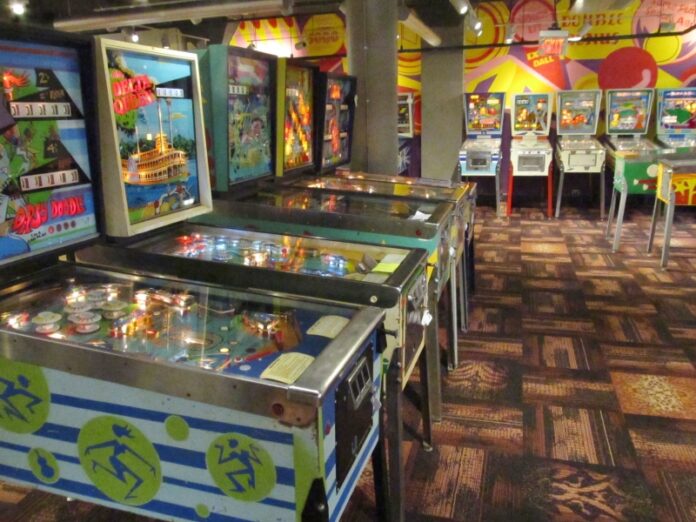
“Ah, it looks like someone got too aggressive with this one.”
Rachel Hopkins, project manager of the new Roanoke Pinball Museum in Center in the Square, looks closer at one of the space’s forty-plus pinball machines. “They tripped the tilt,” she says as she moves to correct the machine. Such is the way of some of the museum’s older machines but everything must be kept in order to keep the new museum running smoothly.
Looking across a 1970s model named Spanish Eyes, she says, “I love the beauty and artwork of these older games.”
The beginning of the museum, located next to the Harrison Museum of African-American Culture, began with Center in the Square member and pinball lover Steve Bowery coming to Hopkins with the idea of opening a pinball museum, and offering up ten to twelve machines from his personal collection. “Within a meeting, we decided that we couldn’t pass this up,” says Hopkins of the quick realizing of the museum’s potential and singular nature.
The museum is one-of-a-kind in Virginia, with the next closest pinball museum in Asheville, NC. Bowery has worked with Hopkins in researching and negotiating purchases of machines.
While funded by both financial support of the Square Society and Center in the Square’s own money, the museum has come to fruition by the efforts of what Hopkins calls “The Founder’s Club,” a group of several people that could offer up their expertise and “sweat equity” rather than money.
One member of the “Founder’s Club” essential to the museum’s creation is David Boyes, a local software engineer who has spent over twenty-five hours a week repairing machines at the museum after learning how to repair them in the past couple of years. His interest in them began while he worked in an arcade as a teenager.
His mission is one of preservation, saying that he started to repair because it’s an art that’s dying out like shoe repair or TV repair shops: “Many items have become disposable and I wanted to help keep pinball machines out of landfills and back in people’s family rooms.” While he aids in repairing the machines to operational status, many other technicians come to the museum to keep them running.
Center in the Square employees have flexed their creativity in building the museum. Former Center intern and museum employee Sydney Barton designed the museum’s murals that pay tribute to local landmarks past and present and Center in the Square Education Manager Tiffany Beheler constructed an “IKEA hack” chandelier out of amusé-bouche cups.
While the museum’s admission desks are refurbished and painted to look like pinball flippers, local business Grand Home Furnishings also donated a large amount of furniture. This type of aid, along with the volunteer help, comes from a respect of how arts and culture affects the local economy, according to Hopkins. “Center in the Square had a $15 million impact on the local community last year and this will only build it up more,” she says.
Machines within the museum range across generations and styles, from a 1948 named “Genco’s Fireball” that has a cabinet with wood enclosing the top glass (these vintage types are called “wood rails”) up to a 2003 “Ripley’s Believe It Or Not” made by Stern Pinball, the “last man standing” out of the five classic pinball machine manufacturers.
There are several pinball “firsts” in the museum such as “Gorgar,” the first machine with speech and “Haunted House,” the first machine with three playable levels. Familiar franchises such as Indiana Jones and Dirty Harry have their own machines along with Elton John.
A sizeable amount of people from all over Virginia have come to see the refurbished machines. Over 1,000 attendees packed the museum for its grand opening and numerous pinball leagues have come down from northern Virginia to check out the games and asked about the museum online. Old and new pinball players alike have been drawn to it, with the nostalgia being a large draw, Boyes points out.
“The museum means “old is now new,” vintage is now cool.”
For more information, visit http://www.roanokepinball.org
– Aaron Layman


